2017 FORD F SERIES MOTORHOME AND COMMERCIAL CHASSIS fuses
[x] Cancel search: fusesPage 5 of 164

Reduced Engine Performance...................51
Economical Driving
.........................................51
Driving Through Water
..................................52
Roadside Emergencies
Roadside Assistance
.....................................53
Hazard Warning Flashers............................54
Jump Starting the Vehicle...........................54
Transporting the Vehicle
.............................56
Customer Assistance
Getting the Services You Need
.................58
In California (U.S. Only)
...............................59
The Better Business Bureau (BBB) Auto Line Program (U.S. Only).......................60
Utilizing the Mediation/Arbitration Program (Canada Only)
...........................61
Getting Assistance Outside the U.S. and Canada...........................................................61
Ordering Additional Owner's Literature.......................................................62
Reporting Safety Defects (U.S. Only)...............................................................63
Reporting Safety Defects (Canada Only)...............................................................63
Fuses
Fuse Specification Chart.............................65
Changing a Fuse
.............................................83
Maintenance
General Information
.....................................85
Under Hood Overview - Commercial Chassis..........................................................86
Under Hood Overview - Motorhome Chassis
...........................................................87
Engine Oil Dipstick
........................................88
Engine Oil Check............................................88
Oil Change Indicator Reset
........................89
Engine Coolant Check
.................................89
Automatic Transmission Fluid Check..............................................................93 Brake Fluid Check
..........................................95
Power Steering Fluid Check.......................97
Fuel Filter
..........................................................98
Changing the 12V Battery...........................98
Changing the Engine Air Filter.................100
Vehicle Care
General Information.....................................101
Cleaning the Exterior....................................101
Cleaning the Engine.....................................102
Cleaning the Alloy Wheels
........................102
Vehicle Storage.............................................103
Wheels and Tires
Tire Care
...........................................................105
Using Snow Chains
......................................120
Changing a Road Wheel
.............................121
Technical Specifications
............................124
Capacities and Specific- ations
Engine Specifications
..................................125
Motorcraft Parts
............................................125
Vehicle Identification Number
.................127
Vehicle Certification Label.........................127
Transmission Code Designation.............128
Capacities and Specifications
.................129
Ford Protect
Ford Protect....................................................134
Scheduled Maintenance
General Maintenance Information
........136
Normal Scheduled Maintenance...........139
Special Operating Conditions Scheduled Maintenance...............................................141
Scheduled Maintenance Record
............143
Appendices
Type Approvals
.............................................154
2
Motorhome (TY3) Canada/United States of America, enUSA, First Printing Table of Contents
Page 48 of 164
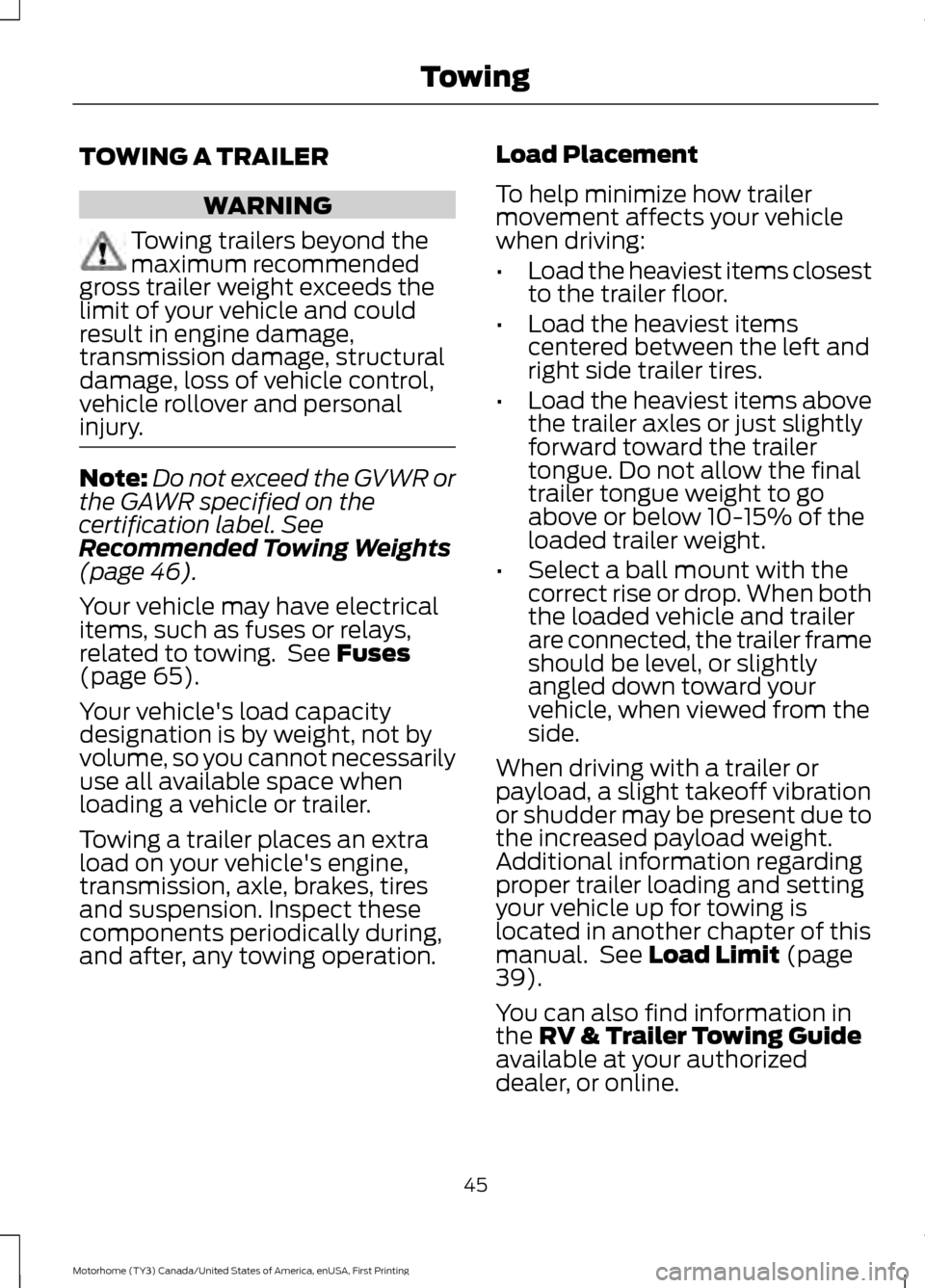
TOWING A TRAILER
WARNING
Towing trailers beyond the
maximum recommended
gross trailer weight exceeds the
limit of your vehicle and could
result in engine damage,
transmission damage, structural
damage, loss of vehicle control,
vehicle rollover and personal
injury. Note:
Do not exceed the GVWR or
the GAWR specified on the
certification label. See
Recommended Towing Weights
(page
46).
Your vehicle may have electrical
items, such as fuses or relays,
related to towing. See
Fuses
(page 65).
Your vehicle's load capacity
designation is by weight, not by
volume, so you cannot necessarily
use all available space when
loading a vehicle or trailer.
Towing a trailer places an extra
load on your vehicle's engine,
transmission, axle, brakes, tires
and suspension. Inspect these
components periodically during,
and after, any towing operation. Load Placement
To help minimize how trailer
movement affects your vehicle
when driving:
•
Load the heaviest items closest
to the trailer floor.
• Load the heaviest items
centered between the left and
right side trailer tires.
• Load the heaviest items above
the trailer axles or just slightly
forward toward the trailer
tongue. Do not allow the final
trailer tongue weight to go
above or below 10-15% of the
loaded trailer weight.
• Select a ball mount with the
correct rise or drop. When both
the loaded vehicle and trailer
are connected, the trailer frame
should be level, or slightly
angled down toward your
vehicle, when viewed from the
side.
When driving with a trailer or
payload, a slight takeoff vibration
or shudder may be present due to
the increased payload weight.
Additional information regarding
proper trailer loading and setting
your vehicle up for towing is
located in another chapter of this
manual. See
Load Limit (page
39).
You can also find information in
the
RV & Trailer Towing Guide
available at your authorized
dealer, or online.
45
Motorhome (TY3) Canada/United States of America, enUSA, First Printing Towing
Page 58 of 164
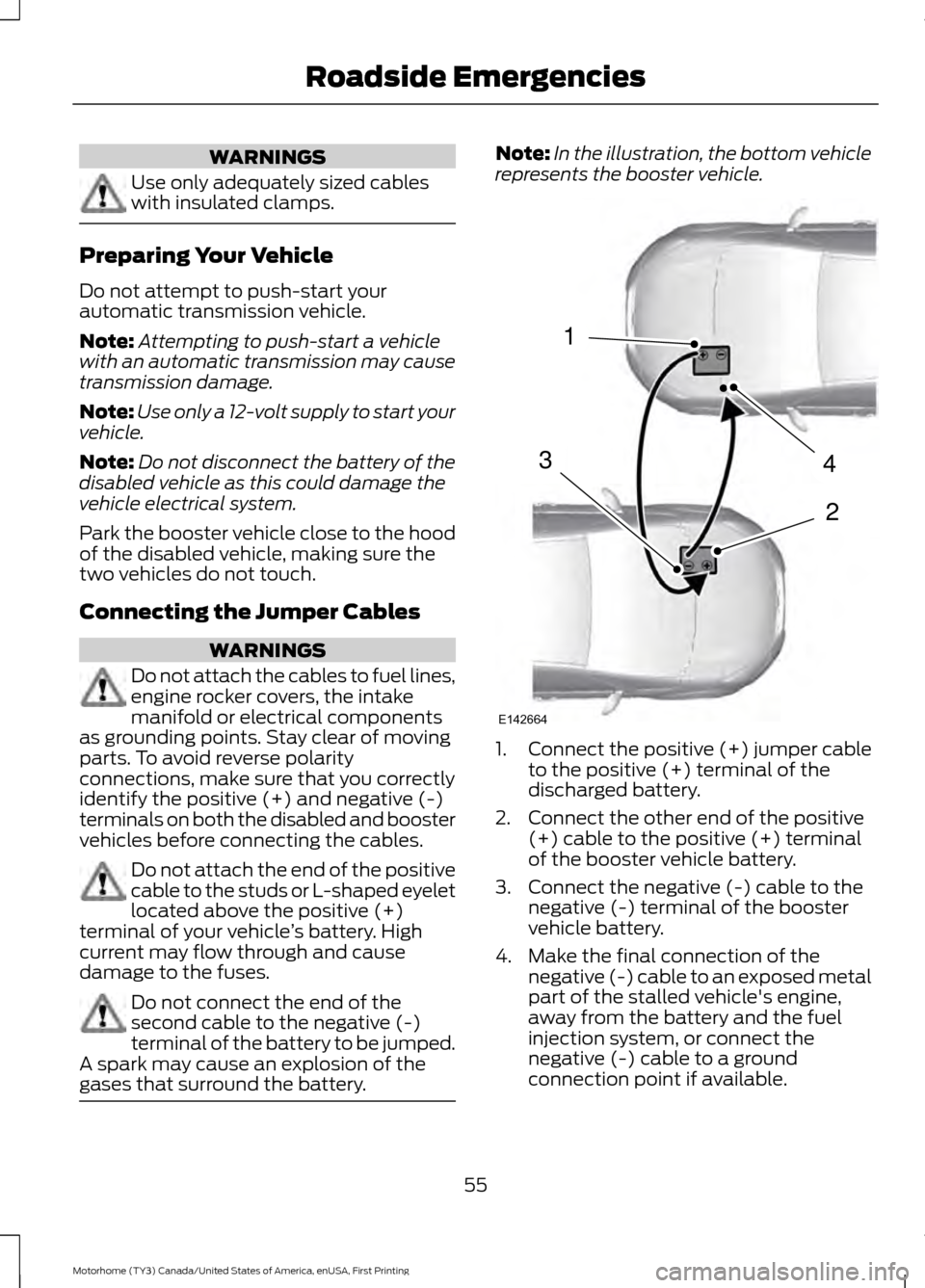
WARNINGS
Use only adequately sized cables
with insulated clamps.
Preparing Your Vehicle
Do not attempt to push-start your
automatic transmission vehicle.
Note:
Attempting to push-start a vehicle
with an automatic transmission may cause
transmission damage.
Note: Use only a 12-volt supply to start your
vehicle.
Note: Do not disconnect the battery of the
disabled vehicle as this could damage the
vehicle electrical system.
Park the booster vehicle close to the hood
of the disabled vehicle, making sure the
two vehicles do not touch.
Connecting the Jumper Cables WARNINGS
Do not attach the cables to fuel lines,
engine rocker covers, the intake
manifold or electrical components
as grounding points. Stay clear of moving
parts. To avoid reverse polarity
connections, make sure that you correctly
identify the positive (+) and negative (-)
terminals on both the disabled and booster
vehicles before connecting the cables. Do not attach the end of the positive
cable to the studs or L-shaped eyelet
located above the positive (+)
terminal of your vehicle ’s battery. High
current may flow through and cause
damage to the fuses. Do not connect the end of the
second cable to the negative (-)
terminal of the battery to be jumped.
A spark may cause an explosion of the
gases that surround the battery. Note:
In the illustration, the bottom vehicle
represents the booster vehicle. 1.
Connect the positive (+) jumper cable
to the positive (+) terminal of the
discharged battery.
2. Connect the other end of the positive (+) cable to the positive (+) terminal
of the booster vehicle battery.
3. Connect the negative (-) cable to the negative (-) terminal of the booster
vehicle battery.
4. Make the final connection of the negative (-) cable to an exposed metal
part of the stalled vehicle's engine,
away from the battery and the fuel
injection system, or connect the
negative (-) cable to a ground
connection point if available.
55
Motorhome (TY3) Canada/United States of America, enUSA, First Printing Roadside Emergencies4
2
1
3
E142664
Page 68 of 164
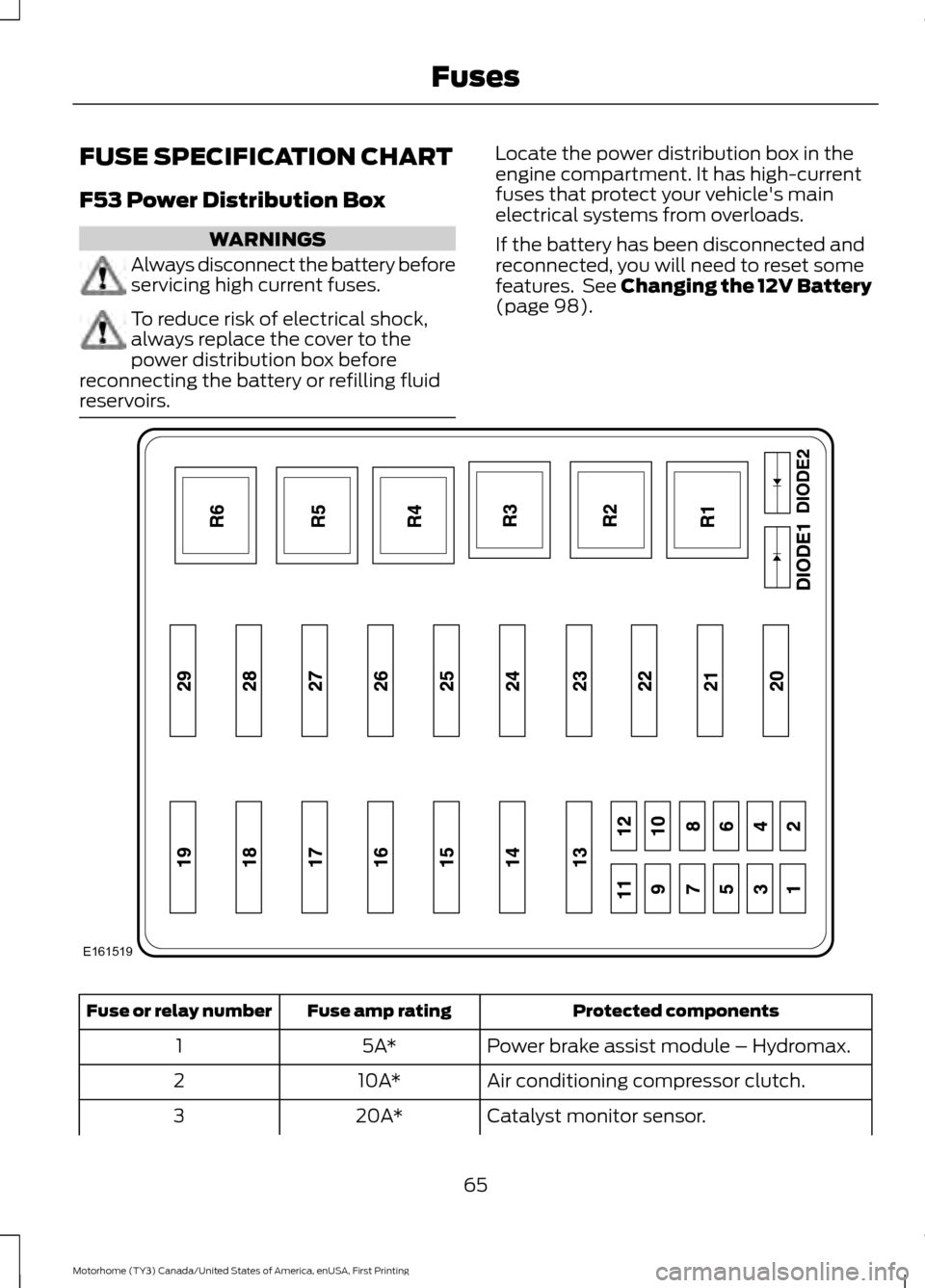
FUSE SPECIFICATION CHART
F53 Power Distribution Box
WARNINGS
Always disconnect the battery before
servicing high current fuses.
To reduce risk of electrical shock,
always replace the cover to the
power distribution box before
reconnecting the battery or refilling fluid
reservoirs. Locate the power distribution box in the
engine compartment. It has high-current
fuses that protect your vehicle's main
electrical systems from overloads.
If the battery has been disconnected and
reconnected, you will need to reset some
features. See Changing the 12V Battery
(page 98).
Protected components
Fuse amp rating
Fuse or relay number
Power brake assist module – Hydromax.
5A*
1
Air conditioning compressor clutch.
10A*
2
Catalyst monitor sensor.
20A*
3
65
Motorhome (TY3) Canada/United States of America, enUSA, First Printing FusesE161519
Page 69 of 164
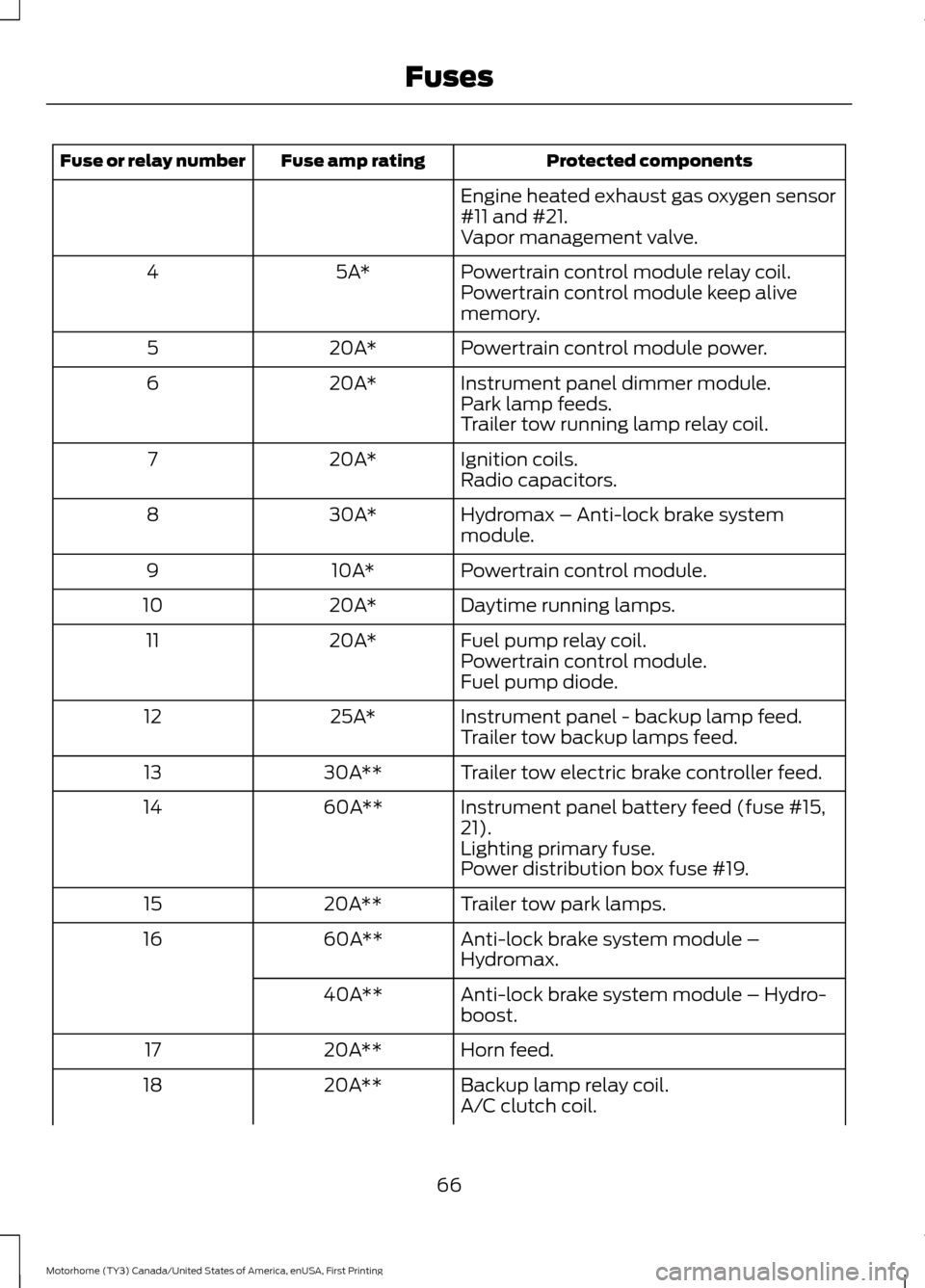
Protected components
Fuse amp rating
Fuse or relay number
Engine heated exhaust gas oxygen sensor
#11 and #21.
Vapor management valve.
Powertrain control module relay coil.
5A*
4
Powertrain control module keep alive
memory.
Powertrain control module power.
20A*
5
Instrument panel dimmer module.
20A*
6
Park lamp feeds.
Trailer tow running lamp relay coil.
Ignition coils.
20A*
7
Radio capacitors.
Hydromax – Anti-lock brake system
module.
30A*
8
Powertrain control module.
10A*
9
Daytime running lamps.
20A*
10
Fuel pump relay coil.
20A*
11
Powertrain control module.
Fuel pump diode.
Instrument panel - backup lamp feed.
25A*
12
Trailer tow backup lamps feed.
Trailer tow electric brake controller feed.
30A**
13
Instrument panel battery feed (fuse #15,
21).
60A**
14
Lighting primary fuse.
Power distribution box fuse #19.
Trailer tow park lamps.
20A**
15
Anti-lock brake system module –
Hydromax.
60A**
16
Anti-lock brake system module – Hydro-
boost.
40A**
Horn feed.
20A**
17
Backup lamp relay coil.
20A**
18
A/C clutch coil.
66
Motorhome (TY3) Canada/United States of America, enUSA, First Printing Fuses
Page 70 of 164
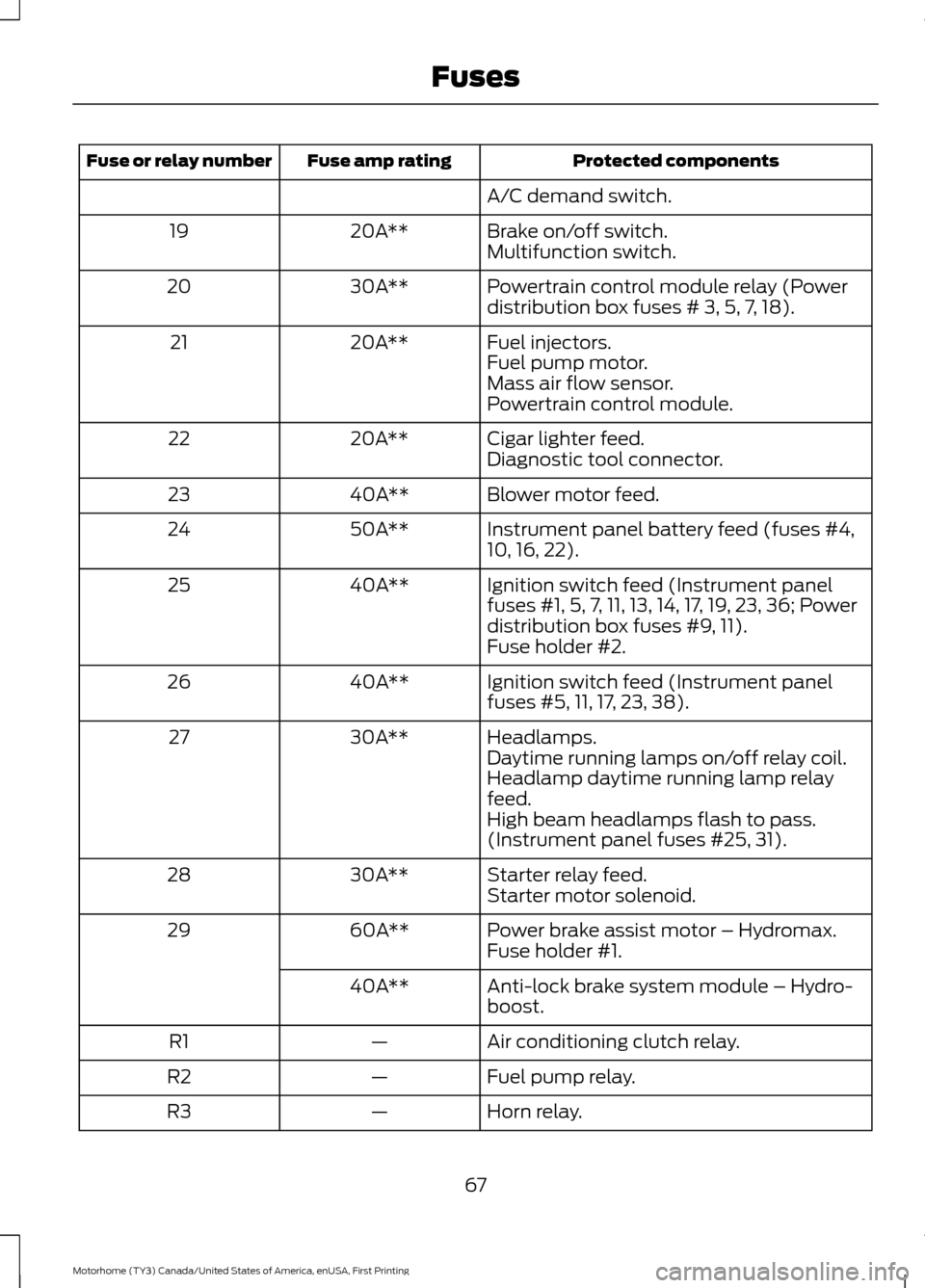
Protected components
Fuse amp rating
Fuse or relay number
A/C demand switch.
Brake on/off switch.
20A**
19
Multifunction switch.
Powertrain control module relay (Power
distribution box fuses # 3, 5, 7, 18).
30A**
20
Fuel injectors.
20A**
21
Fuel pump motor.
Mass air flow sensor.
Powertrain control module.
Cigar lighter feed.
20A**
22
Diagnostic tool connector.
Blower motor feed.
40A**
23
Instrument panel battery feed (fuses #4,
10, 16, 22).
50A**
24
Ignition switch feed (Instrument panel
fuses #1, 5, 7, 11, 13, 14, 17, 19, 23, 36; Power
distribution box fuses #9, 11).
40A**
25
Fuse holder #2.
Ignition switch feed (Instrument panel
fuses #5, 11, 17, 23, 38).
40A**
26
Headlamps.
30A**
27
Daytime running lamps on/off relay coil.
Headlamp daytime running lamp relay
feed.
High beam headlamps flash to pass.
(Instrument panel fuses #25, 31).
Starter relay feed.
30A**
28
Starter motor solenoid.
Power brake assist motor – Hydromax.
60A**
29
Fuse holder #1.
Anti-lock brake system module – Hydro-
boost.
40A**
Air conditioning clutch relay.
—
R1
Fuel pump relay.
—
R2
Horn relay.
—
R3
67
Motorhome (TY3) Canada/United States of America, enUSA, First Printing Fuses
Page 71 of 164

Protected components
Fuse amp rating
Fuse or relay number
Starter relay.
—
R4
Blower motor relay.
—
R5
Powertrain control module relay.
—
R6
Fuel pump diode.
—
Diode 1
Air conditioning clutch diode.
—
Diode 2
*Mini fuses.
**Maxi fuses.
F59 Power Distribution Box 68
Motorhome (TY3) Canada/United States of America, enUSA, First Printing FusesE197657
Page 72 of 164
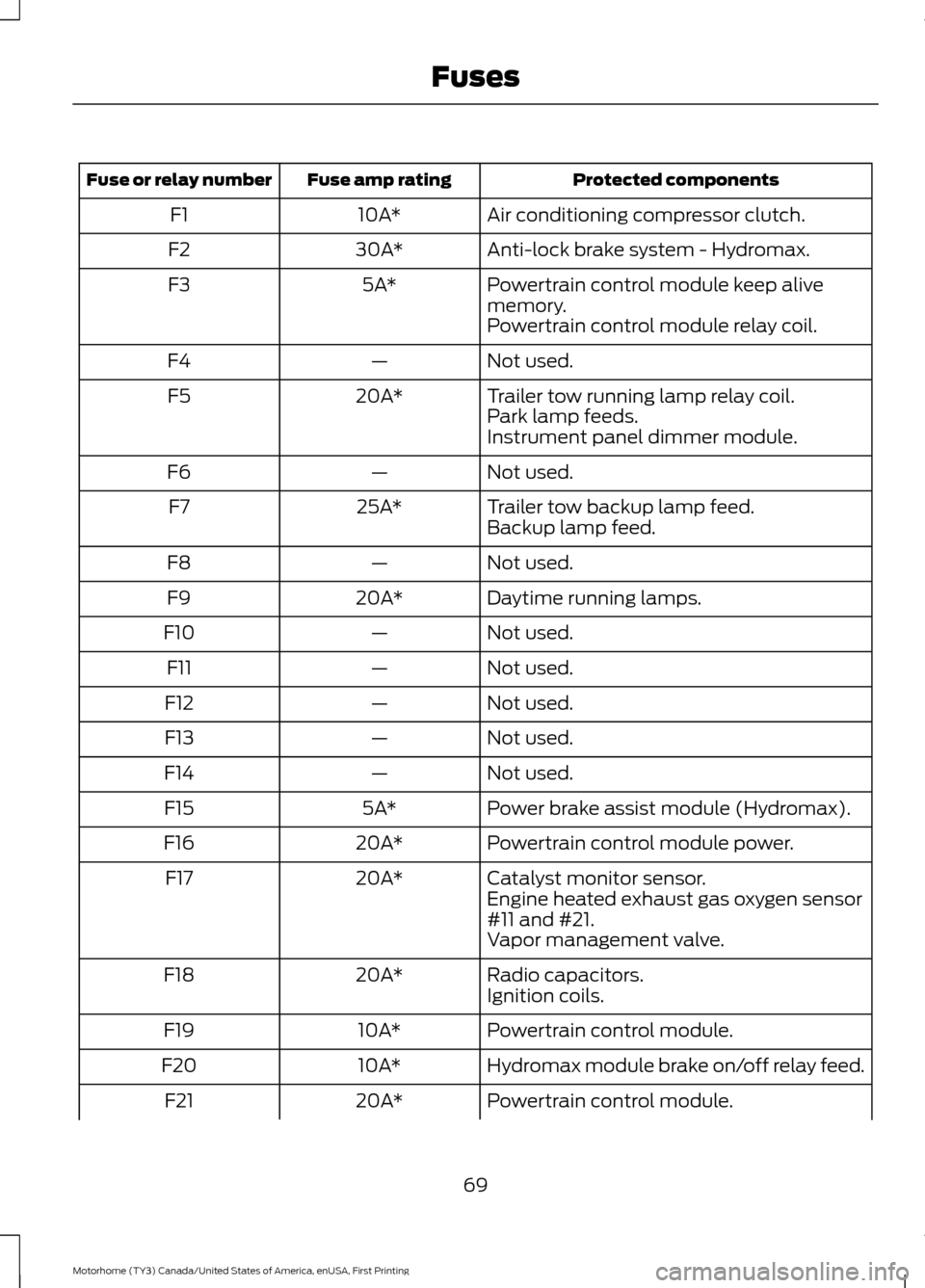
Protected components
Fuse amp rating
Fuse or relay number
Air conditioning compressor clutch.
10A*
F1
Anti-lock brake system - Hydromax.
30A*
F2
Powertrain control module keep alive
memory.
5A*
F3
Powertrain control module relay coil.
Not used.
—
F4
Trailer tow running lamp relay coil.
20A*
F5
Park lamp feeds.
Instrument panel dimmer module.
Not used.
—
F6
Trailer tow backup lamp feed.
25A*
F7
Backup lamp feed.
Not used.
—
F8
Daytime running lamps.
20A*
F9
Not used.
—
F10
Not used.
—
F11
Not used.
—
F12
Not used.
—
F13
Not used.
—
F14
Power brake assist module (Hydromax).
5A*
F15
Powertrain control module power.
20A*
F16
Catalyst monitor sensor.
20A*
F17
Engine heated exhaust gas oxygen sensor
#11 and #21.
Vapor management valve.
Radio capacitors.
20A*
F18
Ignition coils.
Powertrain control module.
10A*
F19
Hydromax module brake on/off relay feed.
10A*
F20
Powertrain control module.
20A*
F21
69
Motorhome (TY3) Canada/United States of America, enUSA, First Printing Fuses